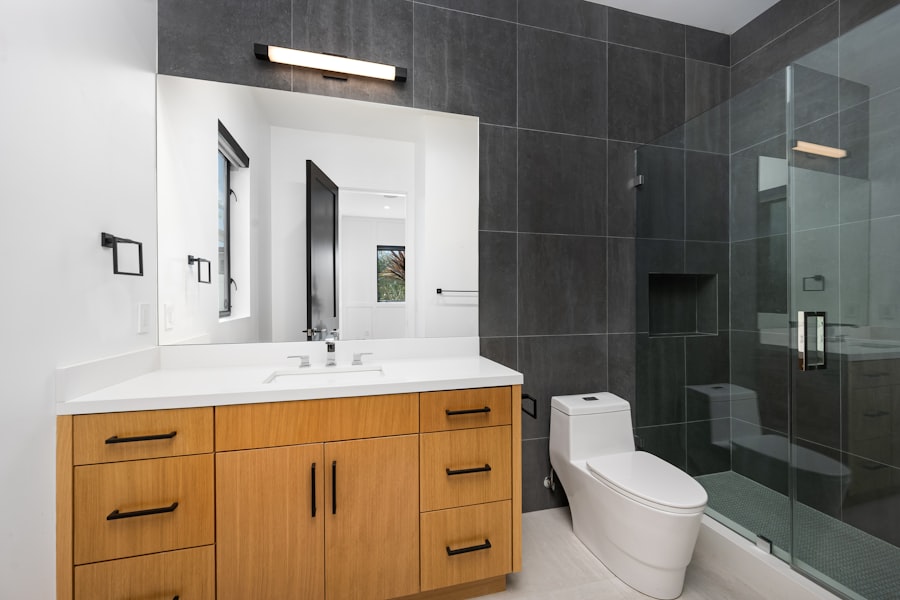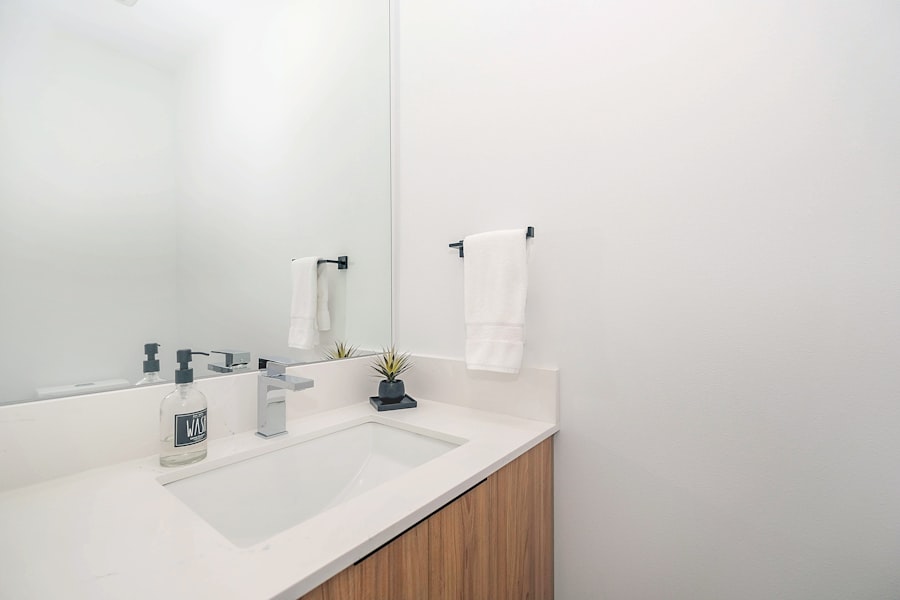A bathroom remodel can range from a simple facelift to a complete overhaul, and understanding the scope of your project is crucial for its success. At its core, a bathroom remodel involves updating or changing the design, layout, fixtures, and finishes of the space. This could mean anything from replacing old tiles and fixtures to reconfiguring the entire layout to improve functionality and aesthetics.
The scope of the remodel will largely depend on your goals, whether they are to enhance the space’s usability, increase property value, or simply refresh its appearance. When considering the scope, it’s essential to evaluate the current state of your bathroom. Are the plumbing and electrical systems up to code?
Is there any water damage that needs addressing? These factors can significantly influence the extent of your remodel. For instance, if you discover mold behind the walls or outdated wiring, you may need to expand your project to include repairs that were not initially planned.
Additionally, understanding how you use your bathroom can help define the scope; for example, a family with children may require more storage and durable materials than a couple looking for a spa-like retreat.
Key Takeaways
- Bathroom remodel costs vary widely based on project scope and materials chosen.
- Key cost factors include labor, fixtures, permits, and unexpected repairs.
- Setting a realistic budget requires researching average costs and prioritizing needs.
- Saving money can involve DIY tasks, shopping sales, and reusing existing elements.
- Managing the budget effectively includes planning for hidden costs and monitoring expenses closely.
Factors that Influence the Cost of a Bathroom Remodel
Several factors can influence the overall cost of a bathroom remodel, and being aware of these can help you make informed decisions. One of the most significant factors is the size of the bathroom. A larger space typically requires more materials and labor, which can drive up costs.
Conversely, a smaller bathroom may allow for a more budget-friendly remodel, but it may also limit your design options. The complexity of the remodel also plays a crucial role; for instance, moving plumbing or electrical fixtures can add significant costs due to the labor involved. Another critical factor is the quality of materials you choose.
High-end finishes such as marble countertops or custom cabinetry can dramatically increase your budget compared to more economical options like laminate or stock cabinetry. Additionally, brand reputation can affect pricing; well-known brands often charge a premium for their products. Labor costs are another consideration; hiring experienced professionals may come at a higher price but can ensure quality workmanship and adherence to local building codes.
Setting a Realistic Budget for Your Bathroom Remodel

Establishing a realistic budget is one of the most important steps in planning your bathroom remodel. Start by determining how much you are willing to spend and what you hope to achieve with your remodel. It’s advisable to allocate a percentage of your budget for unexpected expenses—typically around 10-20%—to account for any surprises that may arise during the renovation process.
This cushion can help prevent financial strain if you encounter issues like hidden water damage or outdated plumbing that needs replacement. To create a detailed budget, break down your costs into categories such as materials, labor, permits, and fixtures. Research average prices for each category based on your desired quality level.
For example, if you plan to install new tile flooring, look into various options and their associated costs. This detailed approach will not only help you stay organized but also allow you to identify areas where you might be able to cut costs without sacrificing quality.
Average Costs for Common Bathroom Remodel Projects
| Project | Average Cost | Cost Range | Notes |
|---|---|---|---|
| Basic Bathroom Remodel | 7000 | 3500 – 10000 | Includes fixtures, paint, and flooring |
| Mid-Range Bathroom Remodel | 15000 | 10000 – 20000 | Upgraded fixtures, new vanity, and tile work |
| High-End Bathroom Remodel | 30000 | 20000 – 45000 | Luxury fixtures, custom cabinetry, and high-end finishes |
| Shower Replacement | 3500 | 1500 – 6000 | Includes new shower pan, walls, and fixtures |
| Bathtub Replacement | 4000 | 2000 – 7000 | Includes tub, surround, and plumbing adjustments |
| Toilet Replacement | 500 | 200 – 1000 | Standard toilet installation |
| Vanity Installation | 1200 | 600 – 2500 | Includes vanity, countertop, and sink |
| Flooring Installation | 1500 | 800 – 3000 | Tile or vinyl flooring |
Understanding average costs for common bathroom remodel projects can provide valuable insight as you plan your renovation. According to industry standards, a mid-range bathroom remodel typically ranges from $10,000 to $15,000. This budget often includes new fixtures, cabinetry, countertops, and flooring.
For example, replacing an old bathtub with a new one can cost anywhere from $1,000 to $5,000 depending on the type and installation complexity. If you’re considering a more extensive remodel that includes moving plumbing or electrical systems, costs can escalate significantly. A full bathroom renovation that involves reconfiguring the layout may range from $15,000 to $25,000 or more.
High-end projects that incorporate luxury materials and custom designs can easily exceed $30,000. Understanding these averages allows homeowners to set realistic expectations and make informed decisions about their remodeling plans.
Ways to Save Money on Your Bathroom Remodel
There are numerous strategies homeowners can employ to save money on their bathroom remodel without compromising quality. One effective approach is to retain the existing layout of the bathroom. Moving plumbing fixtures such as sinks and toilets can be costly due to the labor involved in rerouting pipes and ensuring everything meets code requirements.
By keeping the existing layout intact, you can focus your budget on cosmetic upgrades like new tiles or fixtures. Another way to save is by opting for mid-range materials instead of high-end options. For instance, while natural stone countertops are beautiful, they can be prohibitively expensive.
Consider alternatives like quartz or solid surface materials that offer similar aesthetics at a lower price point. Additionally, shopping sales or clearance items at home improvement stores can yield significant savings on fixtures and finishes.
Hidden Costs to Consider in Your Bathroom Remodel Budget

While planning your bathroom remodel budget, it’s essential to account for hidden costs that may not be immediately apparent. One common oversight is the cost of permits and inspections required by local building codes. Depending on your location and the extent of your remodel, these fees can add up quickly.
Failing to obtain necessary permits can lead to fines or complications when selling your home in the future. Another hidden cost is related to unexpected repairs that may arise during demolition or construction. For example, if you uncover mold or water damage behind walls or under flooring, addressing these issues will require additional funds that were not part of your original budget.
It’s wise to conduct a thorough inspection before starting your remodel and set aside funds specifically for unforeseen repairs.
Deciding whether to hire a professional or tackle a bathroom remodel as a DIY project involves weighing several pros and cons. Hiring professionals offers several advantages, including expertise in design and construction, adherence to building codes, and access to high-quality materials at competitive prices due to established supplier relationships. Professionals also bring experience in managing timelines and coordinating various aspects of the project, which can alleviate stress for homeowners.
On the other hand, DIY projects can be significantly more cost-effective if you have the necessary skills and tools. Tackling tasks such as painting or installing fixtures yourself can save on labor costs while allowing for greater personal involvement in the design process. However, it’s crucial to recognize your limitations; complex tasks like plumbing or electrical work should generally be left to licensed professionals to avoid costly mistakes or safety hazards.
Tips for Managing Your Bathroom Remodel Budget
Effectively managing your bathroom remodel budget requires careful planning and ongoing oversight throughout the project. One key tip is to create a detailed timeline that outlines each phase of the remodel along with associated costs. This timeline should include milestones for purchasing materials, scheduling labor, and completing inspections.
Regularly reviewing this timeline will help ensure that you stay on track financially and avoid overspending. Another important strategy is to maintain open communication with contractors and suppliers throughout the process. Establishing clear expectations regarding costs and timelines can help prevent misunderstandings that could lead to budget overruns.
Additionally, consider using budgeting software or apps designed for home renovations; these tools can help you track expenses in real-time and adjust your budget as needed based on actual spending versus initial estimates. By understanding the scope of your project, considering various factors that influence costs, setting a realistic budget, and being aware of potential hidden expenses, you can navigate your bathroom remodel with confidence and achieve results that meet both your aesthetic desires and financial constraints.




